 Facebook
Facebook
 X
X
 Instagram
Instagram
 TikTok
TikTok
 Youtube
Youtube
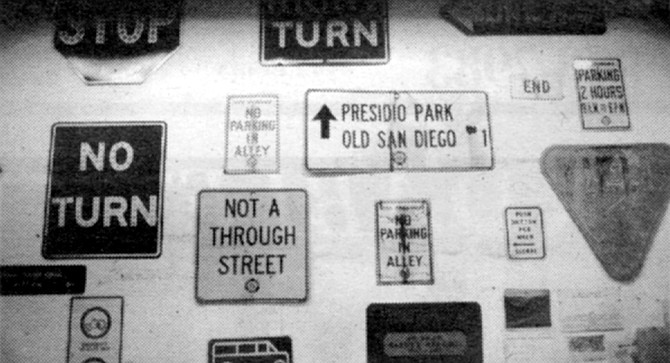
Located in the back of a low, white building at the Chollas maintenance and equipment facility, the City of San Diego’s street and parks sign division is hard to find in a warren of grimly efficient buildings surrounded by cyclone fencing. Here roads are governed by chassis-scarred speed bumps, an empty guard booth confuses late-afternoon visitors, and dumpsters suckle at loading docks in the slanting sunlight.
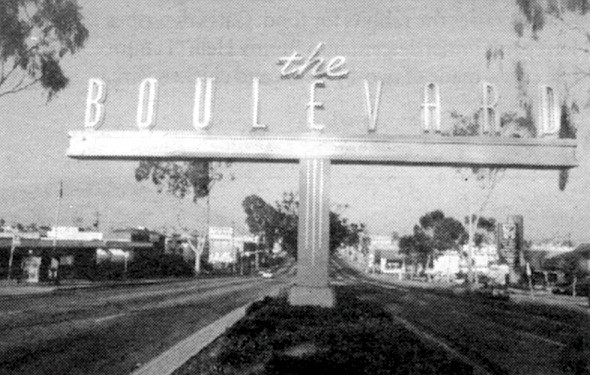
But above one otherwise anonymous door hangs an imaginative hand-painted image of a paintbrush with the words “Sign Shop.” It is an artistic interloper in a world of anonymity, a nod to the days when signs were all painted with only a brush and a steady eye.
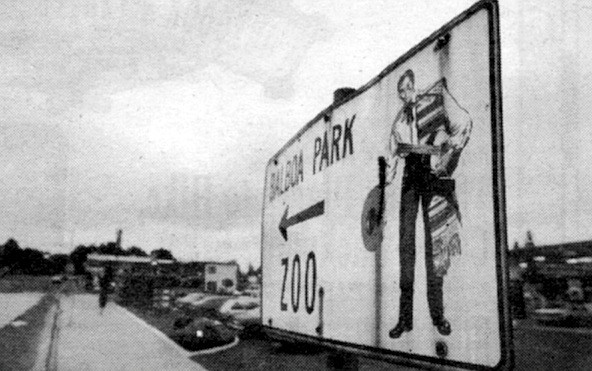
Inside Rodger Blakey is working overtime. The crew here churns out thousands of signs a year, most of them “blades” (street-name signs) and regulatory signs: the images that channel us through a complex San Diego by often telling us what we can’t do. But above a layout table along one wall is a legacy of the sign-maker’s craft. Dozens of historic city signs, rescued over the years by Blakey and his colleagues (and those who worked there long before them), have been nailed to one wall in a rambling graphic display. San Diego’s most infamous sign is there too: “Swimsuits Optional Beyond This Point.” And in another room, a cluster of historic street-name signs, some dating back to the early 1900s, rests atop a storage shelving unit, pointing the way in fine raised black letters on porcelain backgrounds; craftsmanship and style so unlike the computer-cut reflective green signs of today.
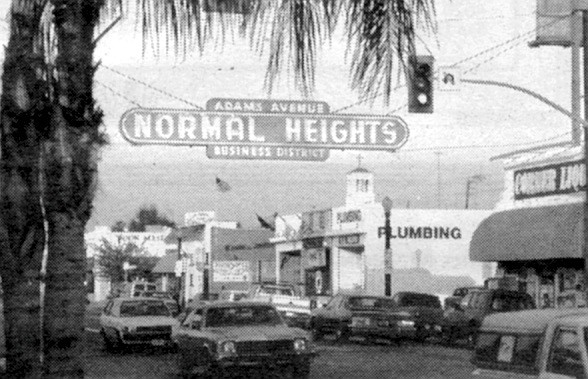
As much as their legal power, signs have emotional might. Why else would something so purely functional enter our collective love of a place, a time, a way to go somewhere — to the point where we grow nostalgic over an old guardrail warning plaque made with an X of red marbles? Or a smiling Don Diego (wonderfully hand-painted but politically incorrect) sweeping his sombrero off to welcome San Diego visitors? Where once we navigated by the stars, chalk marks on cliffs, or graffiti along the trail, today we must use signs. It wasn’t until the automobile that there were so many of them.
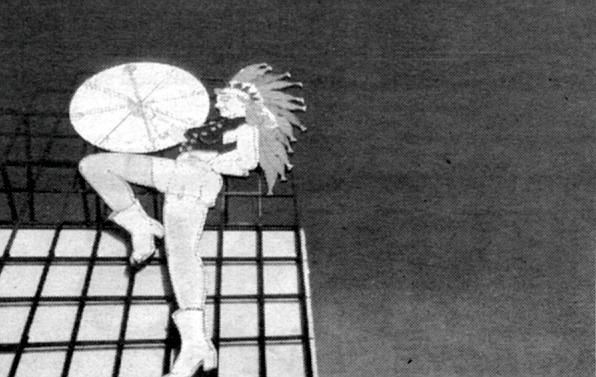
San Diego seems to be at a turning point in its signage history. After years of allowing even its most famous attribute, Balboa Park, to sink beneath a visual compost heap of ugly signage (usually joined by clusters of dented galvanized trash cans), a new signage program has been proposed for San Diego’s green heart.
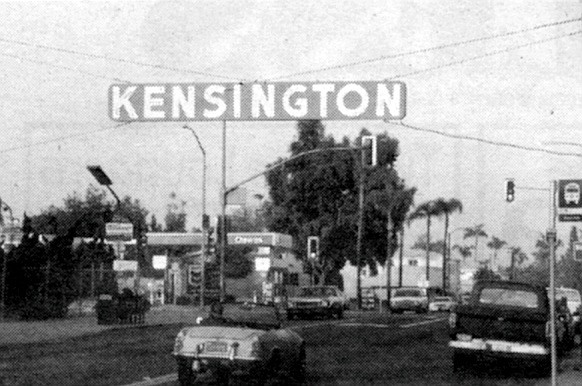
Designer Stuart White, contracted by San Diego to come up with a system of directional and informational signs, created a bold quatrefoil (inspired by architectural ornaments on exposition buildings of 1915) surmounted by the park’s strongest skyline trademark: the California Tower and adjacent dome.
“The park needs identity,” he says, flopping out a thick copy of the newest master plan as we met in his Old Town-area studio. “First, we wanted to be certain this was a total, encompassing program. There’s so much more to Balboa Park than the zoo and a quick stroll down the Prado.”
Signage — especially that designed for the pedestrian who can stop and look — can take the form of complex information kiosks. White’s most successful sign designs are also his largest: an arched panel carries detailed maps on both sides. The maps are rendered in a style that studies have shown to be user-friendly: A bird’s-eye view with key buildings taking shape on a grid of streets and paths. Large and simple to understand, the maps also restore an element of the park that is often missing even in frequent visitors’ vocabularies — the proper names of buildings, plazas, and other features. For ex-ample, in a park full of plazas, which one is Plaza de Panama? Where is the Rube Powell Archery Range?
According to Ed Spicer, a city engineer/project manager who is overseeing the revamping of Balboa Park (including the current construction on the House of Charm), new signs and map panels will begin going in the ground in January 1995. He hopes to have them all in place by the end of 1995. Total cost will be in the range of $900,000, and funding will come from a Certificate of Participation issuance (although specific sign funding still needs a final approval from city council).
Some other major attractions in San Diego, even the zoo, have been notoriously hard to find, primarily because of our mesa and canyon geography, but also thanks to small, hard-to-see — or nonexistent — signs. In Old Town, car after car will drive to the top of the Juan Street hill where Stuart White’s studio is located and stop, the drivers obviously puzzled.
“If I’m outside they ask me, ‘Where’s Old Town?’ ” White says. “I tell them they’ve just driven right through it!”
According to Ruben Andrews, whose firm Graphic Solutions has designed hundreds of signs and sign programs throughout Southern California and did “The Boulevard” sign on El Cajon Boulevard, “San Diego seems to have never reached its arms out and fully welcomed tourists. Signage is one interesting and passive way to do it. For example, small directional signs to churches, historical monuments, and the Cabrillo lighthouse could be created or improved. We need many more interpretive signs on our points of interest. We don’t have the layers of history you find in Europe, but we’re developing them.”
One attribute we do have is weather. Yet despite the best year-round climate in America, San Diego has few signed pathways or hikes through the city that depart from the obvious (the bay-front or beachfront promenades). One can only hope for a time when our Scenic Drive is matched by a Scenic Walk that, let’s say, rambles from the foot of the Cabrillo statue, through downtown and uptown, and winds up at the County Administration Building’s Guardian of the Waters statue.
Too long? Take it in sections. Boston, for example, has a marked walking tour that only the hardiest can complete in entirety, but it is still hugely popular.
Which leads to the question: Do we want our streets busy with tourists, or are we better off keeping them in their ghettoes like Sea World, the Gaslamp, the zoo, and the beaches? Residential neighborhoods typically fight any signage or activity that may lead more cars into their province.
Economically, there’s no question that tourist traffic in communities is good for business. But visitors and commerce aren’t the main factors in many communities’ desire to have point-of-interest or community-name signage. Pride and identity are. The revival of San Diego’s “boulevard” signs (the Normal Heights and Kensington and Hillcrest signs, and the new monument sign “The Boulevard”) is an outright plea for graphic help to offset a cityscape inundated with strip centers, dental office buildings, six-pack apartment complexes, and franchise restaurants. In EastLake, a planned community of Chula Vista, the master developer mandated that residential project names be removed from each phase as they sold out. Instead, some homeowner associations have voted to keep or rebuild their small entry monuments. Other communities, such as Ocean Beach, have created new, alternative forms of signage — particularly landscaping with signature trees. Mexican fan palms, according to Steve Estrada of Estrada Land Planning, who is working with the community groups in O.B., are now a “sign” that you’re there. Community activists have already planted palms in the Robb Field area.
A group of palms, or other tall trees, can be a signal, even from a distance, that something important is happening, like a park or main boulevard. “So you go there,” Estrada says, “led by a ‘visual hierarchy’ of different size and type plants.” And the classic “tree tunnel” is a sure sign that a road is leading somewhere important.
Signs are an ever-evolving public language. Signs in public right-of-ways are governed by federal and state guidelines, as are Caltrans freeway signs. Jonathan Levy, in charge of San Diego’s street division, notes that whenever a sign is replaced, it must be with a state-approved sign. “As a city we don’t control the manual. When a new mandate comes down, we get ten years to implement it.”
A good example is the “SLOW” sign that used to be everywhere. People wanted them in their neighborhoods, on dangerous curves, intersections. But “slow is no longer a legal sign,” says Levy. “It’s too general. Now it must be why you’re supposed to go slow.” In another effort to get more specific and understandable, many signs have moved from words to symbols in the delivery of the message.
San Diego’s “most futile” sign, according to Levy, is “Keep Clear. Do Not Block Intersection.” Despite possible fines, no one seems to pay much attention. Our most requested sign is “Stop.”
The biggest complaint most sign officials and designers have is redundancy. Often because of physical problems with the placement of signs at intersections, small forests of vehicular signs spring up on every corner. Levy has visions of a downtown “cleaned up” by combination sign structures where everything is in one place.
It’s probably no surprise that San Diego has been a leader in the “No Parking” sign field —a driver can’t seem to stop outside their jurisdiction. What’s new are the vinyl wraparound signs on parking meter poles. San Diego “invented” them because of the city shop’s ability to manufacture stick-on vinyl signs, and now other cities are calling for information on how they can do the same thing. Hopefully, many of the taller “No Parking” signs, designed to be read from inside your car, will be removed. After all, if you see a metered space, it’s pretty obvious you’re going to be subject to restrictions.
Levy also wishes that “Walk/Don’t Walk” signs weren’t so compelling in the way they give pedestrians a false sense of security. But they won’t be replaced, primarily because most signals are interactive with traffic, and pedestrians need an electronic way to have their say at an intersection. On a side note, San Diego has three types of audible signs: at railroad crossing guards, on some off ramps warning wrong-way drivers, and the “chirpers,” as Levy calls them. These can be heard guiding those of limited vision at a few potentially confusing downtown intersections (such as Broadway and Third) and up along El Cajon Boulevard near the San Diego Center for the Blind. The bird-call sound is less annoying than other repeated noises and seems pleasant enough (a very boring bird). But listen closely. According to Mark Gould at the center, there’s one set of tones (chirp-chirp) for east/west, another (cuckoo-cuckoo) for north/south.
Ruben Andrews sees signs holding their importance in a visual world. They’ll withstand the in-computer proliferation of icons along the Infobahn as we delve deeper into “virtual realities” of on-line information, shopping, and entertainment. Just as filigreed, gilded, three-dimensional shop signs (such as an elaborate shoe to indicate a cobbler’s shop) were crafted in Salzburg in the 18th and 19th centuries, business owners today still demand an identity that can be imparted only with physical signage. Modern designers call it “project imaging.”
“Change is coming,” Andrews says. “Soon we’ll be ‘throwing’ light on walls, floors, anywhere with lasers. They can even function in the daytime...outstripping the sun. Some of them may flash in a way that your ‘persistence of vision’ will assemble the image, much the way we see a movie at 24 frames per second. It’s sensational, so it will probably be used in retail or entertainment ways.
“And I was in an airport recently where light images were projected on glass or on the floor in front of a store door. I see applications in parking garages, galleries.... Do you see what’s happening? A sign like that can’t be vandalized.” Regulate them, ban them outright, discourage them — signs remain the lingua franca of a hyperdirectional world trying to understand what’s going by the windows.
“We’ll never get rid of them,” says Andrews. “Until we’re all telepathic.”


Located in the back of a low, white building at the Chollas maintenance and equipment facility, the City of San Diego’s street and parks sign division is hard to find in a warren of grimly efficient buildings surrounded by cyclone fencing. Here roads are governed by chassis-scarred speed bumps, an empty guard booth confuses late-afternoon visitors, and dumpsters suckle at loading docks in the slanting sunlight.

But above one otherwise anonymous door hangs an imaginative hand-painted image of a paintbrush with the words “Sign Shop.” It is an artistic interloper in a world of anonymity, a nod to the days when signs were all painted with only a brush and a steady eye.

Inside Rodger Blakey is working overtime. The crew here churns out thousands of signs a year, most of them “blades” (street-name signs) and regulatory signs: the images that channel us through a complex San Diego by often telling us what we can’t do. But above a layout table along one wall is a legacy of the sign-maker’s craft. Dozens of historic city signs, rescued over the years by Blakey and his colleagues (and those who worked there long before them), have been nailed to one wall in a rambling graphic display. San Diego’s most infamous sign is there too: “Swimsuits Optional Beyond This Point.” And in another room, a cluster of historic street-name signs, some dating back to the early 1900s, rests atop a storage shelving unit, pointing the way in fine raised black letters on porcelain backgrounds; craftsmanship and style so unlike the computer-cut reflective green signs of today.

As much as their legal power, signs have emotional might. Why else would something so purely functional enter our collective love of a place, a time, a way to go somewhere — to the point where we grow nostalgic over an old guardrail warning plaque made with an X of red marbles? Or a smiling Don Diego (wonderfully hand-painted but politically incorrect) sweeping his sombrero off to welcome San Diego visitors? Where once we navigated by the stars, chalk marks on cliffs, or graffiti along the trail, today we must use signs. It wasn’t until the automobile that there were so many of them.

San Diego seems to be at a turning point in its signage history. After years of allowing even its most famous attribute, Balboa Park, to sink beneath a visual compost heap of ugly signage (usually joined by clusters of dented galvanized trash cans), a new signage program has been proposed for San Diego’s green heart.

Designer Stuart White, contracted by San Diego to come up with a system of directional and informational signs, created a bold quatrefoil (inspired by architectural ornaments on exposition buildings of 1915) surmounted by the park’s strongest skyline trademark: the California Tower and adjacent dome.
“The park needs identity,” he says, flopping out a thick copy of the newest master plan as we met in his Old Town-area studio. “First, we wanted to be certain this was a total, encompassing program. There’s so much more to Balboa Park than the zoo and a quick stroll down the Prado.”
Signage — especially that designed for the pedestrian who can stop and look — can take the form of complex information kiosks. White’s most successful sign designs are also his largest: an arched panel carries detailed maps on both sides. The maps are rendered in a style that studies have shown to be user-friendly: A bird’s-eye view with key buildings taking shape on a grid of streets and paths. Large and simple to understand, the maps also restore an element of the park that is often missing even in frequent visitors’ vocabularies — the proper names of buildings, plazas, and other features. For ex-ample, in a park full of plazas, which one is Plaza de Panama? Where is the Rube Powell Archery Range?
According to Ed Spicer, a city engineer/project manager who is overseeing the revamping of Balboa Park (including the current construction on the House of Charm), new signs and map panels will begin going in the ground in January 1995. He hopes to have them all in place by the end of 1995. Total cost will be in the range of $900,000, and funding will come from a Certificate of Participation issuance (although specific sign funding still needs a final approval from city council).
Some other major attractions in San Diego, even the zoo, have been notoriously hard to find, primarily because of our mesa and canyon geography, but also thanks to small, hard-to-see — or nonexistent — signs. In Old Town, car after car will drive to the top of the Juan Street hill where Stuart White’s studio is located and stop, the drivers obviously puzzled.
“If I’m outside they ask me, ‘Where’s Old Town?’ ” White says. “I tell them they’ve just driven right through it!”
According to Ruben Andrews, whose firm Graphic Solutions has designed hundreds of signs and sign programs throughout Southern California and did “The Boulevard” sign on El Cajon Boulevard, “San Diego seems to have never reached its arms out and fully welcomed tourists. Signage is one interesting and passive way to do it. For example, small directional signs to churches, historical monuments, and the Cabrillo lighthouse could be created or improved. We need many more interpretive signs on our points of interest. We don’t have the layers of history you find in Europe, but we’re developing them.”
One attribute we do have is weather. Yet despite the best year-round climate in America, San Diego has few signed pathways or hikes through the city that depart from the obvious (the bay-front or beachfront promenades). One can only hope for a time when our Scenic Drive is matched by a Scenic Walk that, let’s say, rambles from the foot of the Cabrillo statue, through downtown and uptown, and winds up at the County Administration Building’s Guardian of the Waters statue.
Too long? Take it in sections. Boston, for example, has a marked walking tour that only the hardiest can complete in entirety, but it is still hugely popular.
Which leads to the question: Do we want our streets busy with tourists, or are we better off keeping them in their ghettoes like Sea World, the Gaslamp, the zoo, and the beaches? Residential neighborhoods typically fight any signage or activity that may lead more cars into their province.
Economically, there’s no question that tourist traffic in communities is good for business. But visitors and commerce aren’t the main factors in many communities’ desire to have point-of-interest or community-name signage. Pride and identity are. The revival of San Diego’s “boulevard” signs (the Normal Heights and Kensington and Hillcrest signs, and the new monument sign “The Boulevard”) is an outright plea for graphic help to offset a cityscape inundated with strip centers, dental office buildings, six-pack apartment complexes, and franchise restaurants. In EastLake, a planned community of Chula Vista, the master developer mandated that residential project names be removed from each phase as they sold out. Instead, some homeowner associations have voted to keep or rebuild their small entry monuments. Other communities, such as Ocean Beach, have created new, alternative forms of signage — particularly landscaping with signature trees. Mexican fan palms, according to Steve Estrada of Estrada Land Planning, who is working with the community groups in O.B., are now a “sign” that you’re there. Community activists have already planted palms in the Robb Field area.
A group of palms, or other tall trees, can be a signal, even from a distance, that something important is happening, like a park or main boulevard. “So you go there,” Estrada says, “led by a ‘visual hierarchy’ of different size and type plants.” And the classic “tree tunnel” is a sure sign that a road is leading somewhere important.
Signs are an ever-evolving public language. Signs in public right-of-ways are governed by federal and state guidelines, as are Caltrans freeway signs. Jonathan Levy, in charge of San Diego’s street division, notes that whenever a sign is replaced, it must be with a state-approved sign. “As a city we don’t control the manual. When a new mandate comes down, we get ten years to implement it.”
A good example is the “SLOW” sign that used to be everywhere. People wanted them in their neighborhoods, on dangerous curves, intersections. But “slow is no longer a legal sign,” says Levy. “It’s too general. Now it must be why you’re supposed to go slow.” In another effort to get more specific and understandable, many signs have moved from words to symbols in the delivery of the message.
San Diego’s “most futile” sign, according to Levy, is “Keep Clear. Do Not Block Intersection.” Despite possible fines, no one seems to pay much attention. Our most requested sign is “Stop.”
The biggest complaint most sign officials and designers have is redundancy. Often because of physical problems with the placement of signs at intersections, small forests of vehicular signs spring up on every corner. Levy has visions of a downtown “cleaned up” by combination sign structures where everything is in one place.
It’s probably no surprise that San Diego has been a leader in the “No Parking” sign field —a driver can’t seem to stop outside their jurisdiction. What’s new are the vinyl wraparound signs on parking meter poles. San Diego “invented” them because of the city shop’s ability to manufacture stick-on vinyl signs, and now other cities are calling for information on how they can do the same thing. Hopefully, many of the taller “No Parking” signs, designed to be read from inside your car, will be removed. After all, if you see a metered space, it’s pretty obvious you’re going to be subject to restrictions.
Levy also wishes that “Walk/Don’t Walk” signs weren’t so compelling in the way they give pedestrians a false sense of security. But they won’t be replaced, primarily because most signals are interactive with traffic, and pedestrians need an electronic way to have their say at an intersection. On a side note, San Diego has three types of audible signs: at railroad crossing guards, on some off ramps warning wrong-way drivers, and the “chirpers,” as Levy calls them. These can be heard guiding those of limited vision at a few potentially confusing downtown intersections (such as Broadway and Third) and up along El Cajon Boulevard near the San Diego Center for the Blind. The bird-call sound is less annoying than other repeated noises and seems pleasant enough (a very boring bird). But listen closely. According to Mark Gould at the center, there’s one set of tones (chirp-chirp) for east/west, another (cuckoo-cuckoo) for north/south.
Ruben Andrews sees signs holding their importance in a visual world. They’ll withstand the in-computer proliferation of icons along the Infobahn as we delve deeper into “virtual realities” of on-line information, shopping, and entertainment. Just as filigreed, gilded, three-dimensional shop signs (such as an elaborate shoe to indicate a cobbler’s shop) were crafted in Salzburg in the 18th and 19th centuries, business owners today still demand an identity that can be imparted only with physical signage. Modern designers call it “project imaging.”
“Change is coming,” Andrews says. “Soon we’ll be ‘throwing’ light on walls, floors, anywhere with lasers. They can even function in the daytime...outstripping the sun. Some of them may flash in a way that your ‘persistence of vision’ will assemble the image, much the way we see a movie at 24 frames per second. It’s sensational, so it will probably be used in retail or entertainment ways.
“And I was in an airport recently where light images were projected on glass or on the floor in front of a store door. I see applications in parking garages, galleries.... Do you see what’s happening? A sign like that can’t be vandalized.” Regulate them, ban them outright, discourage them — signs remain the lingua franca of a hyperdirectional world trying to understand what’s going by the windows.
“We’ll never get rid of them,” says Andrews. “Until we’re all telepathic.”
Comments